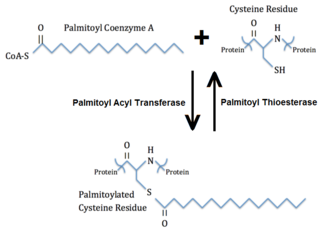
In molecular biology, palmitoylation is the covalent attachment of fatty acids, such as palmitic acid, to cysteine (S-palmitoylation) and less frequently to serine and threonine (O-palmitoylation) residues of proteins, which are typically membrane proteins. The precise function of palmitoylation depends on the particular protein being considered. Palmitoylation enhances the hydrophobicity of proteins and contributes to their membrane association. Palmitoylation also appears to play a significant role in subcellular trafficking of proteins between membrane compartments, as well as in modulating protein–protein interactions.

Carnitine palmitoyltransferase I (CPT1) also known as carnitine acyltransferase I, CPTI, CAT1, CoA:carnitine acyl transferase (CCAT), or palmitoylCoA transferase I, is a mitochondrial enzyme responsible for the formation of acyl carnitines by catalyzing the transfer of the acyl group of a long-chain fatty acyl-CoA from coenzyme A to l-carnitine. The product is often palmitoylcarnitine, but other fatty acids may also be substrates. It is part of a family of enzymes called carnitine acyltransferases. This "preparation" allows for subsequent movement of the acyl carnitine from the cytosol into the intermembrane space of mitochondria.
Palmitoyl-CoA hydrolase (EC 3.1.2.2) is an enzyme in the family of hydrolases that specifically acts on thioester bonds. It catalyzes the hydrolysis of long chain fatty acyl thioesters of acyl carrier protein or coenzyme A to form free fatty acid and the corresponding thiol:

Palmitoyl protein hydrolase/thioesterases is an enzyme (EC 3.1.2.22) that removes thioester-linked fatty acyl groups such as palmitate from modified cysteine residues in proteins or peptides during lysosomal degradation. It catalyzes the reaction
In enzymology, a 1-acylglycerol-3-phosphate O-acyltransferase is an enzyme that catalyzes the chemical reaction
In enzymology, a 1-acylglycerophosphocholine O-acyltransferase is an enzyme that catalyzes the chemical reaction
In enzymology, a 2-acylglycerol-3-phosphate O-acyltransferase is an enzyme that catalyzes the chemical reaction
In enzymology, a 2-acylglycerol O-acyltransferase is an enzyme that catalyzes the chemical reaction
In enzymology, a 2-acylglycerophosphocholine O-acyltransferase is an enzyme that catalyzes the chemical reaction

Carnitine O-octanoyltransferase is a member of the transferase family, more specifically a carnitine acyltransferase, a type of enzyme which catalyzes the transfer of acyl groups from acyl-CoAs to carnitine, generating CoA and an acyl-carnitine. Specifically, CROT catalyzes the chemical reaction:
In enzymology, a dolichol O-acyltransferase is an enzyme that catalyzes the chemical reaction
In enzymology, a glycerol-3-phosphate O-acyltransferase is an enzyme that catalyzes the chemical reaction
In enzymology, a glycine N-acyltransferase (GLYAT), also known as acyl-CoA:glycine N-acyltransferase (ACGNAT), is an enzyme that catalyzes the chemical reaction
In enzymology, a glycoprotein N-palmitoyltransferase is an enzyme that catalyzes the chemical reaction
In enzymology, a glycoprotein O-fatty-acyltransferase is an enzyme that catalyzes the chemical reaction
In enzymology, a [myelin-proteolipid] O-palmitoyltransferase is an enzyme that catalyzes the chemical reaction
In enzymology, a retinol O-fatty-acyltransferase is an enzyme that catalyzes the chemical reaction

In enzymology, a serine C-palmitoyltransferase (EC 2.3.1.50) is an enzyme that catalyzes the chemical reaction:
In enzymology, sphingosine N-acyltransferases (ceramide synthases (CerS), EC 2.3.1.24) are enzymes that catalyze the chemical reaction of synthesis of ceramide:
Fatty acyl-CoA esters are fatty acid derivatives formed of one fatty acid, a 3'-phospho-AMP linked to phosphorylated pantothenic acid (vitamin B5) and cysteamine.





